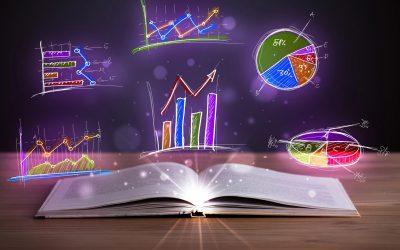Data storytelling might be thought of as a high level version of paint-by-numbers.
First the data storyteller arranges data points on the canvas based on the question(s) being asked. Then we interpret the stories that emerge in a way most valuable to stakeholders. The moral of the stories might be profitability, customer satisfaction, team turnover, or some other KPIs.
But data storytelling done well is more than data analysis and telling stories through pretty charts and graphs.
The stakes are high for data storytellers to weave a story that stands out among the noise. After all, no company is in business to be less competitive, less creative, less innovative, less strategic, and less forward thinking than its peers.
The fact that organizations have access to nearly immeasurable quantities of data makes the role of data storyteller even more important.
2020 statistics show that companies use approximately 32% of data available to them, leaving the other 68% unutilized (Seagate/IDC).
With data storytelling stakes so high, it seems worth asking another question – what is the catalyst between the data and the story? What is the connection between source material and story? What is the missing piece, the bridge between data and storytelling?
The best data storytelling requires a deep understanding of the human experience. We are, after all, telling human stories. Each data point represents one pixel of the human experience. Therefore isn’t data analysis really human behavioral analysis? And storytelling, the telling of behavior fueled stories?
Data Lessons From Memoir Writing
This idea of catalyzing source content into complete stories is a familiar one for me as a memoir specialist of over 20 years.
Here are 3 lessons I learned about human behavior from my work with memoir authors:
#1: Sometimes it’s the outlier stories, the afterthoughts, the “oh by the way is this anything?” part of the author conversations that pack the biggest punch.
Humans often have an instinct to stop digging for answers right before the biggest moments of discovery.
#2: Story is story is story, whether fiction, nonfiction, book, screenplay, or data. It involves selecting the best structure to deliver the reader promise, using emotion as a tool (including curiosity, excitement, or apprehension over the data insights) to engage the reader (“Wow look at that!”), and sticking the landing (“Now what?”).
Humans are naturally drawn to the ebbs, flows, promises, tensions, releases, and payoffs of a well-told story
#3: Painting mental pictures rules! In book writing, authors have to rely purely on words to guide the reader’s mental paintbrush. In data storytelling we get to use actual visuals to help tell our stories to stakeholders.
Behavioral Storytelling
Humans are visual creatures, and this carries over to our behavior. We are constantly looking for visual cues (even if in our mind), searching for patterns and trends, and then attempting to make predictions based on what we see.
As much as it drives books and other writing, an understanding of human behavior also drives data storytelling.
“Data storytelling is powerful for communicating data insights, but it requires diverse skills and considerable effort from human creators.” (Wang & Qu, 2024)
The human behavioral element of data storytelling might also be a key piece of the equation that AI cannot replicate. The level of data storytelling that companies need to remain competitive goes beyond straightforward analysis and interpretation. The most compelling stories, the ones that move readers, move the needle, and in the case of data storytelling, move audiences and stakeholders, explore WHY people do the things they do. They hold up a mirror and reflect our own choices through the choices of others.
How does this connect to data storytelling which, rather than aiming to move book readers, aims to move decision makers, margins, and money? The addition of deep human behavioral understanding to data analysis adds a new dimension of WHY.
- Why did the data lead us to the conclusions it did?
- Why is the main story of the data the main story?
- Why did the individual data points, which ultimately reflect human choices (buying, staffing, etc.), line up the way they did?
- Which choices, behaviors, and patterns generate any outliers or other data surprises?
The better we as data storytellers can understand the psychology at the heart of the data points, the better we can be at predicting where the data stories might go next for our clients, foreseeing the next chapters of their organizational stories.
References:
Li, H., Wang, Y., & Qu, H. (2024). Where Are We So Far? Understanding Data Storytelling Tools from the Perspective of Human-AI Collaboration. Proceedings of the CHI Conference on Human Factors in Computing Systems, 1–19. https://doi.org/10.1145/3613904.3642726




0 Comments